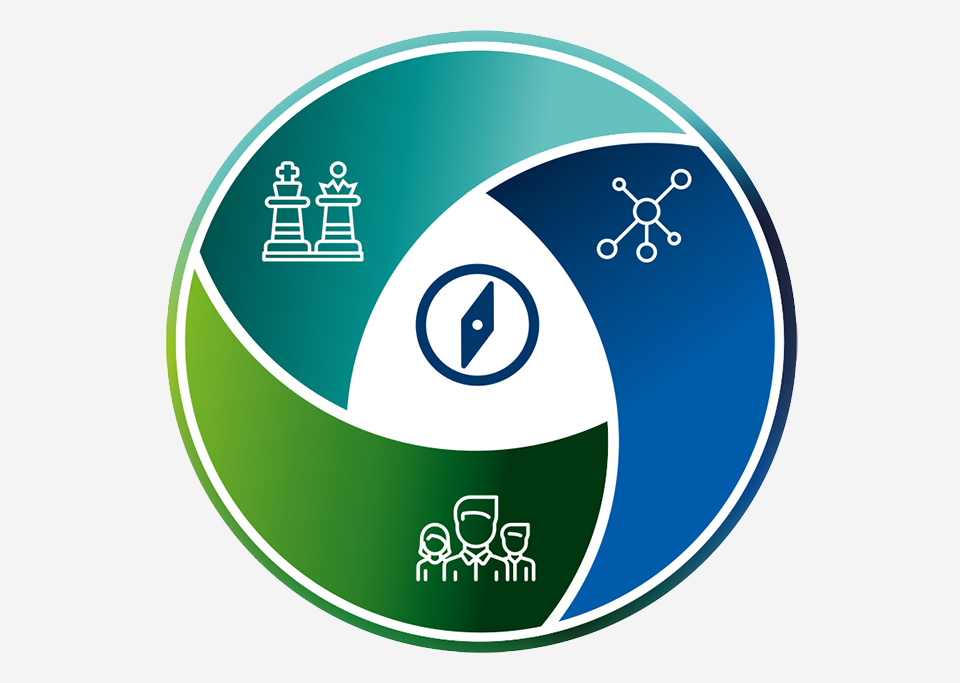Digitalization and the growing complexity of markets have greatly accelerated innovation cycles in recent years. Companies must proactively adapt to dynamic and constant changes in order to remain fit for the future.

Digitalization and the growing complexity of markets have greatly accelerated innovation cycles in recent years. Companies must proactively adapt to dynamic and constant changes in order to remain fit for the future.
Importance of organizational ability to change
Organizations must constantly renew and modernize their service portfolio. This is not new. What is new, however, is the speed at which this is happening.
In particular, the socio-economic, ecological, and political dynamics of recent years have shown us how massively dynamic developments in the relevant environments accelerate innovation cycles and challenge the adaptability and innovative strength of organizations. Organizations are challenged to develop new and creative solutions in a fast-paced competitive environment in order to continue to meet the needs of their customers.
Organizations are successful when they are highly responsive to societal developments, find valuable solutions to societal bottlenecks and needs, and market them in a targeted manner.
If the needs of relevant target groups change, the value attached to the services provided changes. Organizations are faced with the enormous challenge of observing developments in their relevant environments and finding innovative solutions that they can implement quickly and whose value they can market in a targeted and credible manner.
How can organizational ability to change be strengthened?
The requirements of customers and markets are changing. Careful observation of the relevant environments is therefore indispensable for organizations – only in this way can the changes be perceived, needs for action and opportunities be identified at an early stage, and solutions be developed.
Numerous examples of organizational blindness show that this is often easier said than done.
Often, management already does a very good job here and develops promising concepts – however, these change projects fail far too often in implementation and do not achieve the hoped-for results. This not only leads to cynicism and change fatigue among managers and employees but also costs the organization a lot of energy.
Organizational blindness

Organizations only see what they see. They do not see that they do not see what they do not see.
In their perception of their environment, organizations follow certain observation and evaluation patterns that have been established and consolidated over the years. This makes sense and is important because, without these patterns, organizations would not be able to act. However, this creates blind spots: Relevant developments around the organization are not perceived because they are not seen as such due to the established observation and evaluation criteria. You can read how to counteract this risk in our article on systems theory in practice.

How can change succeed? What is the importance of interlocking strategy, organization and personnel?
Read more and download our free digital presentation on successful transformation processes.
Effectively interlinking strategy, organization, and personnel
The reason why change projects in organizations do not succeed is often that they do not take the organization as a whole into account. A change in strategy, for example, in many cases also requires adjustments in the organizational structure. In addition, managers and employees may need to be prepared for new tasks or different processes. However, all of this must be taken into account. Particularly in the case of far-reaching organizational transformation processes, the effective interlinking of strategy, organizational, and personnel development is necessary in order to design and implement them successfully.
In addition, it is important to establish a fit between the change objectives and the corporate culture. If there are too many discrepancies here, the corporate culture can hinder the change project or even lead to its failure. If the currently practiced corporate culture restricts the company’s performance, cultural development makes sense. In all these processes, leadership plays a decisive role as a co-creator and role model in the change. As change navigators, managers must therefore be closely involved in all processes to ensure that the change succeeds at all levels.
Change does not equal change
Changes in organizations can take on very different dimensions and forms. We distinguish between the following three stages:
- First-order change: adjustments that are part of the natural optimization of an organization, e.g. the introduction of new software
- Second-order change: responses to an acute change event, e.g., crisis management or the recognition of a problem that requires radical restructuring
- Third-order change: Improving an organization’s ability to learn and adapt in order to identify opportunities early on and avoid radical restructuring. This can be achieved on the one hand through genotypical transformation and on the other hand through forward-looking self-renewal
A successful change of change, i.e. a third-order change, requires this triad of strategy, organization, and personnel – and we have been playing it skillfully as a systemic organizational consultancy for over 35 years. Taking into account the elements of corporate culture and leadership, we effectively interweave relevant processes and implement communication and decision-making routines and working methods. This enables your organization to recognize and react to relevant needs for action and opportunities in the markets at an early stage.
Programs to strengthen future viability
Innovation power, development of corporate culture, ability to change
Our consulting services
In order to successfully shape the transformation of a company, the triad of strategy, organization, and personnel is essential. As systemic organizational consultants, we have special expertise in dealing with the interdependencies within a company. With us, you have all services under one roof and experts at your side.

Strategy
Develop your strategy with us to actively shape the future even in times of uncertainty.
Organization
Together with you, we will answer the question of which organization your organization needs.
Personnel
Ensure the performance of your organization with new HR solutions, now and in the future.
Leadership
Establish a form of leadership that enables constant organizational adaptation to the challenges of the times
Culture
A culture that fits the strategic goals of an organization significantly increases organizational performance.
Together with you, we create solutions that do not yet exist today
 Frédéric SedlákSenior Consultant | HR Management
Frédéric SedlákSenior Consultant | HR ManagementWe are always at your service+49 4102 69 93 22
Ask for free informationf.sedlak@spconsulting.de
Further information
If you would like to learn more about us and our consulting approach, we look forward to a personal conversation with you! Simply make an uncomplicated appointment with us.

Online
Make a non-binding inquiry and specify your expectations
 Frédéric SedlákSenior Consultant | HR Management
Frédéric SedlákSenior Consultant | HR ManagementWe are always at your service+49 4102 69 93 22
Ask for free informationf.sedlak@spconsulting.de








